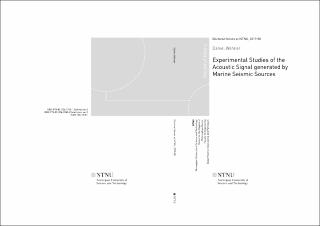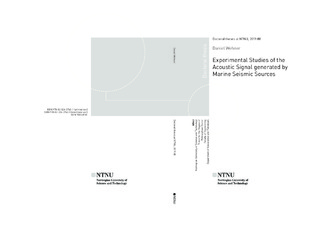| dc.contributor.advisor | Landrø, Martin | |
| dc.contributor.advisor | Arntsen, Børge | |
| dc.contributor.author | Wehner, Daniel | |
| dc.date.accessioned | 2019-07-09T16:02:15Z | |
| dc.date.available | 2019-07-09T16:02:15Z | |
| dc.date.issued | 2019 | |
| dc.identifier.isbn | 978-82-326-3763-8 | |
| dc.identifier.issn | 1503-8181 | |
| dc.identifier.uri | http://hdl.handle.net/11250/2603955 | |
| dc.description.abstract | Marine seismic acquisition is the most commonly used geophysical technique to image the subsurface for different purposes, e.g. exploration of reservoirs or investigation of subduction zones as areas where earthquakes are generated. The acquisition consists of a sound source emitting the signal into the subsurface and dedicated sensors which receive the reflected signals from the subsurface structures of interest. The most common sound source used in marine seismics over the last 50 years is the airgun. The airgun is a mechanical device releasing high pressurized air from a chamber into the surrounding water within a few milliseconds. The acoustic source signal consists of a sharp peak when the pressurized air is released followed by an oscillation corresponding to the expanding and contracting air bubble in water. The main advantages of the airgun are its signal repeatability and long lifetime. However, the emitted frequency bandwidth is limited by the oscillation period and the destructive interference of the direct downgoing wavefield with the first reflection from the sea surface, referred to as the ghost. In recent years there has been increasing interest in improving two major aspects of the sound source in marine seismic acquisition. The first aspect is the enhancement of emitted low frequency signals (< 5 Hz) which are beneficial for imaging of deep targets, especially below salt or basalt structures which scatter and reflect most of the higher frequencies. In addition, low frequencies are beneficial for velocity model building in full waveform inversion. The second aspect is the reduction of high frequencies (> 100-200 Hz) which can have an impact on marine life, e.g. masking communication or behavioural disturbances. Therefore, alternative source types, e.g. marine vibrators, are developed and investigations are conducted on how to tune the signal emitted by airguns.
The thesis consists of several, individual manuscripts where the acoustic signal generated by single marine seismic sources, especially from airguns, is experimentally investigated. Several experiments are conducted to study the mechanisms that have an impact on the low frequency content of the emitted sound signal. First, the signal generated by the rising airgun bubble is investigated separately from the main peak and oscillating bubble by dedicated experiments with rising buoys and the results are compared to measured airgun signatures. Secondly, the impact of the spherical wave front on the ghost reflection is studied for different source-interface distances in a tank experiment. Third, the impact of the interaction between the airgun bubble and sea surface on the source signature is investigated for very shallow source depths and the variations of the oscillating bubble and ghost reflection are discussed. In addition, the signal emitted into air is analyzed for these shallow seismic sources. Another study deals with the reduction of high frequency emission from seismic airguns. The impact of bubble curtains surrounding an airgun on the source signature and high frequency emission are investigated for different bubble curtain configurations.
The results from the rising airgun bubble indicate a low frequency signal emitted by this movement. However, the signal strength is low and seems to have no significant impact in marine seismic acquisition. The results for the spherical wave front indicate that the low frequency signal (< 1-2 Hz) could be enhanced with decreasing source depth. However, the noise level at this frequency band is usually strong and it needs to be further investigated how large the impact could be in field applications. The results from the source-interface interaction indicate that the low frequency signal (< 5 Hz) is strongly enhanced when the airgun bubble bursts directly at the water surface and no oscillations occur. This effect seems to be promising to enhance the low frequency signal in field applications. The results from the bubble curtain surrounding the airgun indicate a gradually decreasing frequency content above 50 Hz with increasing air injection into the bubble curtain. Hence, bubble curtains could potentially be considered to reduce high frequency emissions from airguns. | nb_NO |
| dc.language.iso | eng | nb_NO |
| dc.publisher | NTNU | nb_NO |
| dc.relation.ispartofseries | Doctoral theses at NTNU;2019:80 | |
| dc.relation.haspart | Wehner, Daniel; Landrø, Martin; Amundsen, Lasse.
On low frequencies emitted by air guns at very shallow depths - An experimental study. Geophysics 2019 ;Volum 84.(5) s. P61-P71
https://doi.org/10.1190/geo2018-0687.1 | |
| dc.relation.haspart | Wehner, Daniel; Landrø, Martin; Amundsen, Lasse; Westerdahl, Harald.
Frequency-depth-dependent spherical reflection response from the sea surface - a transmission experiment. Geophysical Journal International 2018 ;Volum 214.(2) s. 1206-1217
- This article is published and distributed under the terms of the Oxford University Press, Standard Journals Publication Model (https://academic.oup.com/journals/pages/about_us/legal/notices) © The Author(s) 2018. Published by Oxford University Press on behalf of The Royal Astronomical Society.
https://doi.org/10.1093/gji/ggy196 | |
| dc.relation.haspart | Wehner, Daniel; Landrø, Martin.
Low-frequency acoustic signal created by rising air-gun bubble. Geophysics 2017 ;Volum 82.(6) s. P119-P128
https://doi.org/10.1190/geo2016-0674.1 | |
| dc.relation.haspart | Wehner, Daniel; Landrø, Martin.
The Impact of Bubble Curtains on Seismic Air Gun
Signatures and its High Frequency Emission
The final published version is available in
GEOPHYSICS(2020),85(2):P1
http://dx.doi.org/10.1190/geo2019-0451.1 | |
| dc.relation.haspart | Wehner, Daniel; Svensson, Peter; Landrø, Martin.
The Coupling of Marine Seismic
Source Signals into Air
The final published article is available in The Journal of the Acoustical Society of America 147, 1092 (2020); https://doi.org/10.1121/10.0000691 | |
| dc.relation.haspart | Wehner, Daniel; Borges, Filipe; Landrø, Martin.
Tube wave monitoring - detect
shear modulus and S-wave
velocity changes in the
formations surrounding wells | |
| dc.title | Experimental Studies of the Acoustic Signal generated by Marine Seismic Sources | nb_NO |
| dc.type | Doctoral thesis | nb_NO |
| dc.subject.nsi | VDP::Teknologi: 500::Berg‑ og petroleumsfag: 510 | nb_NO |

